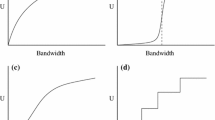Abstract
This paper presents Quality of Service (QoS) based routing and priority class assignment algorithms. It introduces an end-to-end delay margin balancing approach to routing, and uses it to formulate a nonlinear optimization problem. In a single-class network, the formulation is shown to be convex; however in a multi-class priority network, it is only convex within specific regions, and is infeasible otherwise. A centralized off-line computation technique is proposed to calculate both the route configuration and end-to-end priority assignment. A gradient-based solution in the convex region and a heuristic to overcome the multi-class discontinuity are derived. An approximation of the optimization problem is developed for on-line distributed processing is then presented. Using the approximation, arriving traffic flows can use vector routing tables to search for routes. Compared with minimum-hop, minimum-delay, and min-interference routing algorithms, the proposed approach enables the single-class network to accommodate more users of different end-to-end delay requirements. In a multi-class priority network, results show that using the objective function to combine route and priority class assignment further increases the supportable network traffic volume.
Similar content being viewed by others
References
M. Ashour and T. Le-Ngoc, End-to-End Delay Satisfaction Balancing Routing, in: Proceedings Globecom (Nov. 2005).
M. Ashour and T. Le-Ngoc, Delay Satisfaction End-to-End Priority Assignment and Routing in Multi-Class Priority Networks, in: Proceedings IEEE International Conference on Quality of Service in Heterogeneous Wired/Wireless Networks (Aug. 2005).
P. Aukia, M. Kodialam, P.V.N. Koppol, T.V. Lakshman, H. Sarin and B. Suter, RATES: a server for MPLS traffic engineering, IEEE Network 14-2 (March–April 2000) pp. 3–41.
S. Blake et al., An Architecture for Differentiated Services (RFC-2475, Dec. 1998).
Crawley et al., A Framework for QoS-based Routing in the Internet (RFC 2386, Aug. 1998).
D.P. Bertsekas, Network Optimization Continuous and Discrete Models (Athena Scientific, 1998).
C. Dovrolis and P. Ramanathan, Dynamic class selection: From relative differentiation to absolute QoS, in: Proceedings Ninth International Conference on Network Protocols (11–14 Nov. 2001) pp. 120–128.
B. Fortz and M. Thorup, Internet traffic engineering by optimizing OSPF weights, in: Proceeding IEEE INFOCOM 2 (March 2000) pp. 519–528.
R. Gallager, A minimum delay routing algorithm using distributed computation, IEEE Transaction on Communication, Vol. 25, No. 1 (Jan. 1977) pp. 73–85.
M. Geral and L. Kleinrock, On the topological design of distributed computer networks, IEEE Transaction on Communication, Vol. 25, No. 1 (Jan. 1977) pp. 48–60.
J.F. Hayes, Thimma V.J. Ganesh Babu, Modeling and Analysis of Telecommunications Networks (John Wiley & Sons, 2004)
K. Kar, M. Kodialam and T.V. Lakshman, Minimum interference routing of bandwidth guaranteed tunnels with MPLS traffic engineering applications, IEEE Journal of Selected Areas in Communication, Vol. 18, No. 12 (Dec. 2000) pp. 2566–2579.
J.F. Keningtom, A survey of linear multicommodity network flows, Operational Research, Vol. 2, No. 26 (1978) pp. 209–236.
A. Ouorou, P. Mahey and J.-Ph. Vial, A survey of algorithms for convex multicommodity flow problems, Management Sciences Vol. 46, No. 1 (Jan. 2000) pp. 126–147.
S. Shenker et al., Specification of Guaranteed Quality of Service (RFC 2212 Sept. 1997).
B. Sanso, F. Soumis and M. Gendreau, On the evaluation of telecommunication reliability using routing models, IEEE Trans. on Communication, Vol. 39, No. 10 (Oct. 1991) pp. 1494–1501.
D. Awduche et al., RSVP-TE: extensions to RSVP for LSP Tunnels (RFC 3209 Dec. 2001).
H. Tahilramani Kaur, T. Ye, S. Kalyanaraman and S. Kennth Vastola, Minimizing Packet Loss by Optimizing OSPF Weights Using On-line Simulation, in: Proceedings IEEE International Symposium on Modeling, Analysis, and Simulation of Computer and Telecommunications Systems (2003) pp. 79–86.
F. Wang, P. Mohapatra, S. Mukherjee and D. Bushmitch, A random early demotion and promotion marker for assured services, IEEE Journal on Selected Areas in Communications, Vol. 18, No. 12 (Dec. 2000) pp. 2640–2650.
Author information
Authors and Affiliations
Corresponding author
Additional information
Mohamed Ashour received his B.Sc. (1991) and M.Sc. (1997) in Electrical Engineering from Ain Shams University, Cairo, Egypt. He worked for Hughes and General Dynamics as a Telecommunications Engineer. Currently, he is a Ph.D. Candidate in the Department of Electrical and Computer Engineering of McGill University, Montreal, Quebec, Canada. His current area of research is focused on traffic engineering, routing, and QoS provisioning in DiffServ and MPLS Networks. He is also interested in multi-class queuing analysis of long-range traffic, and QoS provisioning in ad hoc networks and satellite communications.
Tho Le-Ngoc obtained his B. Eng. (with Distinction) in Electrical Engineering in 1976, his M.Eng. in Microprocessor Applications in 1978 from McGill University, Montreal, and his Ph.D. in Digital Communications 1983 from the University of Ottawa, Canada.
During 1977–1982, he was with Spar Aerospace Limited as a Design Engineer and then a Senior Design Engineer, involved in the development and design of the microprocessor-based controller of Canadarm (of the Space Shuttle), and SCPC/FM, SCPC/PSK, TDMA satellite communications systems.
During 1982–1985, he was an Engineering Manager of the Radio Group in the Department of Development Engineering of SRTelecom Inc., developed the new point-to-multipoint DA-TDMA/TDM Subscriber Radio System SR500. He was the System Architect of this first digital point-to-multipoint wireless TDMA system.
During 1985–2000, he was a Professor the Department of Electrical and Computer Engineering of Concordia University. Since 2000, he has been with the Department of Electrical and Computer Engineering of McGill University.
His research interest is in the area of broadband digital communications with a special emphasis on Modulation, Coding, and Multiple-Access Techniques. He is a Senior Member of the Ordre des Ingénieur du Quebec, a Fellow of the Institute of Electrical and Electronics Engineers (IEEE), a Fellow of the Engineering Institute of Canada (EIC), and a Fellow of the Canadian Academy of Engineering (CAE). He is the recipient of the 2004 Canadian Award in Telecommunications Research, and recipient of the IEEE Canada Fessenden Award 2005.
Rights and permissions
About this article
Cite this article
Ashour, M., Le-Ngoc, T. End-to-end delay margin balancing approach for routing in multi-class networks. Wireless Netw 13, 311–322 (2007). https://doi.org/10.1007/s11276-006-7527-9
Published:
Issue Date:
DOI: https://doi.org/10.1007/s11276-006-7527-9




